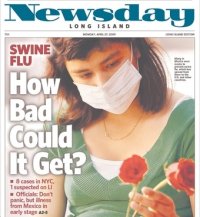A year into H1N1, a call for better vaccine technology


(Shown is the cover of Newsday, the daily newspaper I grew up on, at the height of the panic last May.)
Were we going too fast? Were we going too slow? Were were all going to die? Was the cure worse than the disease?
My introduction to China came a month later, when a crew dressed like we were a hazardous waste site got on our plane in Shanghai and took everyone's temperature. Lots of famous people were detained, and some never got into the country, before it became clear the virus was coming in anyway. It was tougher than a Mexican dishwasher.
The course authorities finally settled on was to declare a pandemic, create a separate vaccine for H1N1, using the same production techniques as for seasonal flu, and the same distribution methods.
The result was a panic to get the first supplies, followed by ennui that left millions of dollars in vaccine unused, suitable only for the landfill.
The government is now defending its approach. Flu.Gov features a review of the last year, but also a film about the 1918 pandemic, which killed 10 times more Americans than died in World War I.
What seems clear in retrospect was that there were no good choices. The only reliable route to vaccination was through chicken eggs. Failure to vaccinate would have been an unconscionable risk.
But there other ways, as we reported at ZDNet. A single vaccine could be used against many different types of flu. We could find other ways to produce vaccine, leading to product that is more shelf stable.
One of the biggest winners in the whole H1N1 panic may have been Crucell, a vaccine maker which got a major investment from Johnson & Johnson that will help it maintain its independence.
More work is needed on shelf stable, egg-free vaccine technologies, and on scaling them. But that work is continuing.
Next time H1N1 strikes, perhaps this winter, we shouldn't be panicking.